Farmoor Reservoirs represent a welcome conundrum to anyone who enjoys a bit of variety in their fishing. How do you choose between fantastic, grown-on trout (including some huge browns) and some cracking pike on the fly? I still hadn’t completely made my mind up when I arrived on a chilly morning in late February, waiting for Thomas Finney, a talented young fly angler who I’ve got to know through the Fly For Coarse competition (when not bothering trout, he catches some stunning carp, perch and other species).
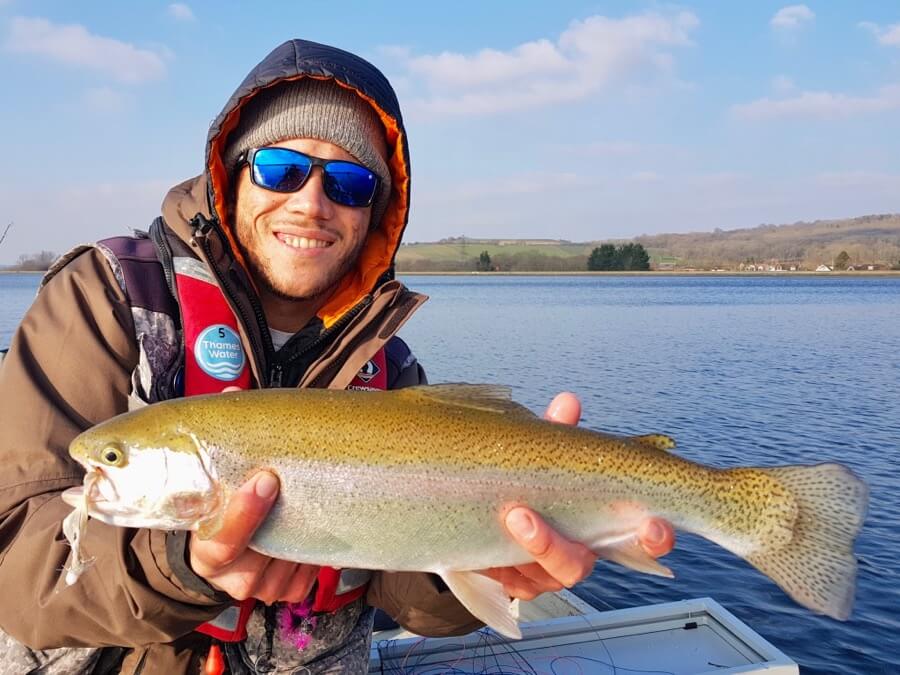
Perhaps it was the sudden cold snap and bitter easterly winds that decided for us in the end. And the fact that my friend Will Barnard had been raving about the quality of trout fishing with overwintered fish, recommending that we have a crack on Farmoor 1. Both this lake and Farmoor number 2 are what you’d call concrete bowls, but bloody hell do they produce some fine fish. With number 1 being catch and release though, a lot grow on to become big and athletic fish. So while I had been dreaming about getting a large pike on the fly, I felt that could perhaps wait till later in the day.
In spite of temperatures already starting to bite, Tom was enthusiastic. It’s always a pleasure to fish with an angler who really excels at a particular method- and in his case, boat fishing these larger reservoirs is a bit of a speciality. I got a different insight into the world of fly fishing from a boat, to put it mildly, from specialist tactics to competition rules that are fussier than a parking attendant with migraine.
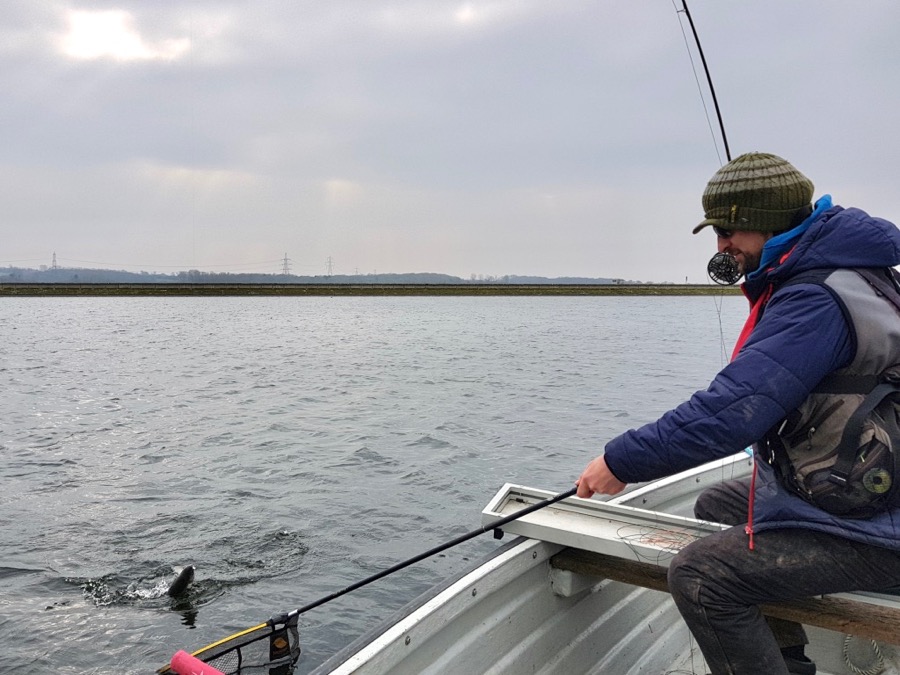
Fly fishing tactics and kit for cold weather
One of the first rules of winter and early season fly fishing has to be comfort. You can’t fish well if you’re cold or sitting awkwardly, or have your kit all over the shop. A bib and brace is one of the best things a die hard winter angler could ever buy for starters; but besides warmth, most of us could also do our backs a favour. I’ll admit that as someone who doesn’t boat fish every week, I’ve never bothered buying a boat seat. But in this case it made so much difference I wondered why I’ve never invested.
In terms of tackle, leader lengths were also critical. No matter how many times we are told, a lot of anglers use leaders that are just too short. And while most of us will go longer for buzzers and nymphs, we still use stubby little leaders for lures and sinking lines. It takes a little getting used to then, but a leader of at least 15 ft is ideal, even with a lure on point and another lure on the dropper! Tom won’t go much below 10lb fluorocarbon on Farmoor 1, due to the possibility of hooking a large fish. Even the three pounders go like stink here, after all. We went for fast sinking lines, and stiff seven weight rods made sense in the wind too.
The recent catch reports for Farmoor looked good. Despite a chilly start to 2018, rod averages for Farmoor 1 were around eight fish, even with the weather brass monkeys! Not put off by the Siberian conditions then, I thought we were going to have a great day when the very first drift produced. We began with a Humungous (or “Huey” in Tom-speak), him going for white, me for black. Second cast in and Tom had a real pull-your-arm-off first fish. The way it burned off, I thought it was going to be bigger, too. Fantastically full-tailed and not an ounce of fat on it.

Fly fishing on the “Hang” (yes, even in late winter…)
Even in the cold conditions, I was quite intrigued to hear how many fish would follow flies right up to the boat- and it was quite a lesson to watch Tom fish the “hang”. Most of us know about this method of raising and holding the flies right at the end of the cast, but we do it much too quickly. Observe a well-practised competition angler and it is really gradual; the whole thing often takes at least 20-30 seconds, eyes watching all the while for a follower. On a couple of occasions, there was a really big shape behind the fly too!
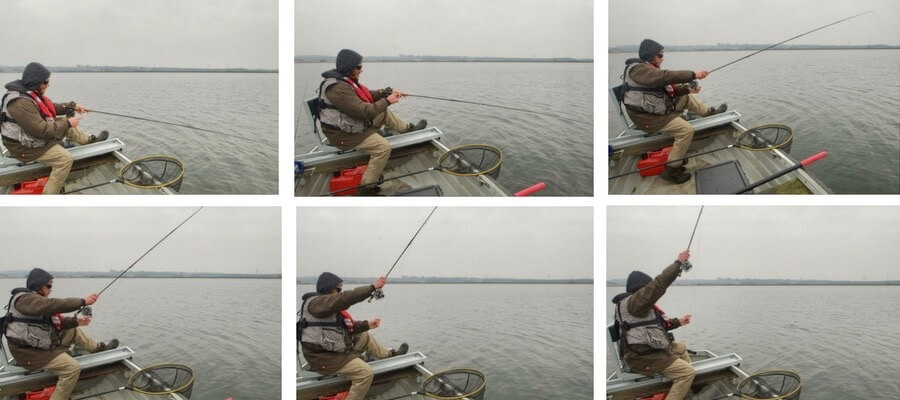
A good hanging: Raise your rod and flies by slow degrees, without rushing!
I repeat that most of us (myself included!) do this too quickly. We’re too eager to make the next cast, but Tom has learned the hard way to finish each cast patiently (“the number of times I’ve seen a good fish following, just as I pulled my flies out of the water!“). If you lift the rod too high and and too quickly, the effect isn’t quite right. The hang should be slow and vigilant, with a gentle figure of eight as the last few feet of fly line show (a marker at ten feet can be handy on your fly line, whether you use a special line or add with whipping silk).
A good reminder for me to slow down then, but with the breeze quickly stiffening, my better poise wasn’t rewarded. It took quite a while for either of us to win another take, in fact, and when it arrived it wasn’t quite what we were expecting. A pike had grabbed Tom’s Lure. The fight was short but angry. Luckily the teeth didn’t cut the fluorocarbon (although we’d never advocate using fluorocarbon for pike, he does land a few accidental predators like this each season).

From there on in, though, our fortunes appeared to worsen the stronger the wind got. The trout disappeared for a while and I couldn’t tempt a pike either, as we tried one or two drifts a little closer to the shore. Where had the fish gone? Were they absent or just off the boil?
The answer, we eventually decided, was a hot chocolate and a bite to eat in the lodge cafe. Would we like a massive cup with marshmallows and everything piled on top, asks the chap? What a silly question. After that biting wind, it tasted even better.

Our fingers were pretty numb, after all, and we needed a bit of warmth and something to lift our morale. Not that calories were all we picked up, because our stop at the lodge also provided a bit of insight from other sheltering anglers, too. From what we gathered the pike and perch fishing had been hard lately- but we heard from a pair who’d been fishing really deep with their soft plastics that they were getting quite a few accidental knocks from trout, right on the bottom.
A switch of plan…
A change of tactics was called for then, as we steeled ourselves for a fresh assault on Farmoor One. Off came the standard lures and on went the Boobies. Now, you can say what you like about Boobies (no, not those kind of boobies), but they are a legitimate type of fly that can be really important. And this is never truer when conditions are crap (well, not many of us would hope for an ugly north easterly and temperatures down to freezing).
Unless we’re talking throw them out and leave the rod in a rest, Boobies still require thought and skill too. I only very rarley ever use them, to be quite honest, and when I have it’s tended to be on a small stillwater with the conventional tiny leader and sink-like-a-stone line.
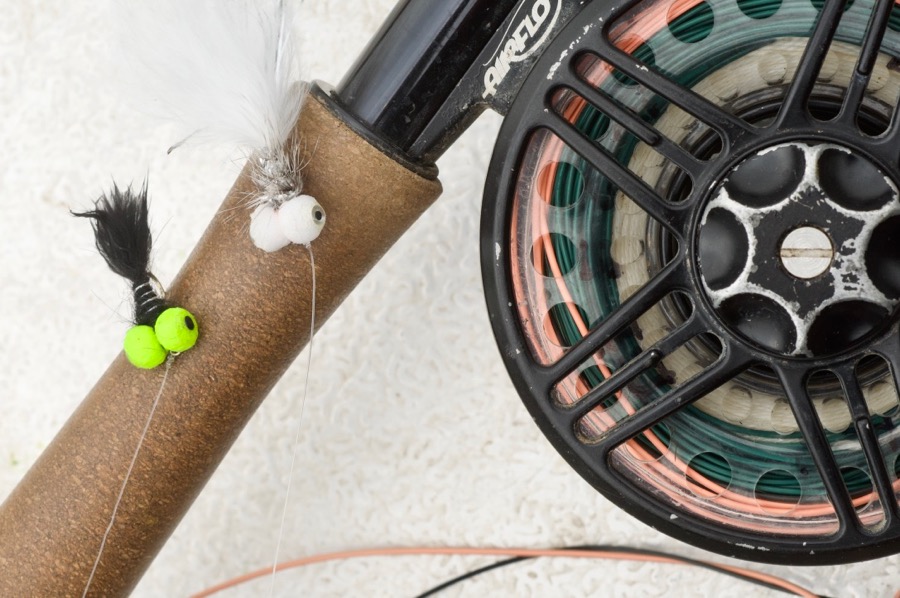
By comparison then, Tom’s reservoir tactics were a lot more sophisticated. A leader of 12 or more feet seemed long, but allowed us to fish one fly on a dropper just 3-4 feet off the bottom and a point fly a little higher. Even with lures, there is no sin in using two flies on a big reservoir, in fact, and it was only when doubling up I seemed to get as many bites as Tom. As much as I like the idea of being a bit more “pure” and just going with one pattern, two flies simply draw more fish in.
Getting a slow drift again with the drogue, we cast and paid out a little line from the boat, patiently letting the flies sink, before imparting a patient-to-barely-moving retrieve. Apart from the odd little hurry-up, we did this creepingly patiently, with a slow-motion figure of eight.
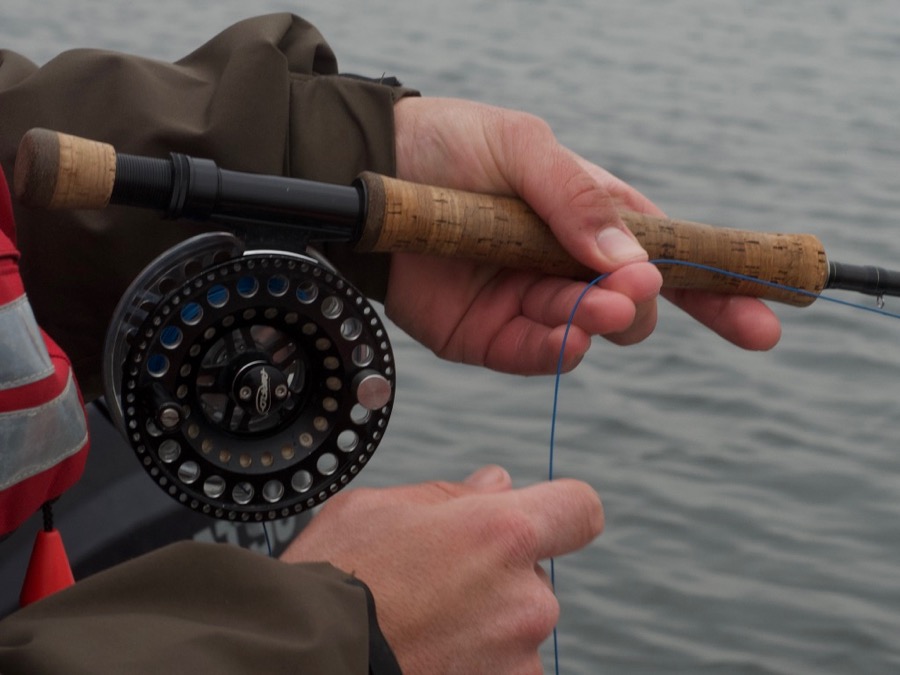
One thing I noticed all through the day is that Tom uses a “pull and pinch” retrieve. In other words, this means clamping down on the fly line between thumb and forefinger after every pull on the line (as above). This is so that when a fish pulls back, it finds immediate resistance and is more likely to get hooked, rather than just stealing a few inches of line before the angler can pull back. So simple, but like a lot of subtle but important details, so easily overlooked!
We were soon rewarded too, as we drifted along the near bank perhaps seventy yards from shore. The flies were getting futher down with this more patient approach and takes were the opposite to our gentle retrieves- real slammers! How lovely to feel that thumping presence on the line too, after such a slow morning. You won’t find too many anglers who wax lyrical about the joy of sinking lines, compared to dry fly sport for example, but the fish fought really well. With the added depth and weight of the heavier lines, I find there is certainly a bit of added weight and tension too, as you guess how big the fish will be.
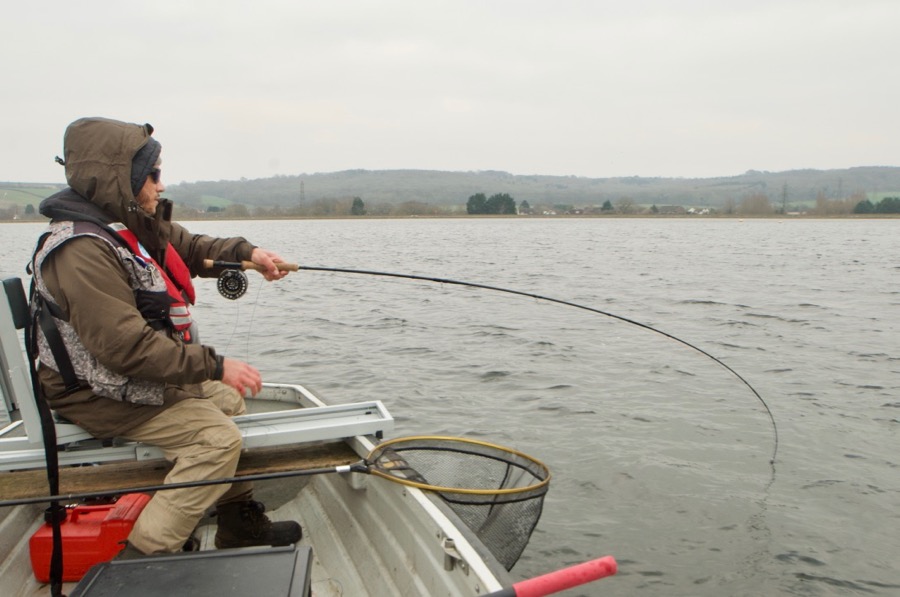
Another noticeable aspect when you watch a seasoned competition angler in action is how low they keep the rod when playing a fish. Why? Well, if the fish comes straight towards the boat, changes direction or you suddenly need to pick up some slack, you can then lift the rod to pick up extra line and keep in touch. If your rod is already high, you cannot get as much extra lift/ leverage at a moments notice and it’s much easier for the fish to momentarily gain some slack. These details matter, and not only to the angler in a match, but to anyone enduring a hard day where every fish counts.
Tom managed another full-tailed long-term resident or two, while I seemed to tangle mostly with smaller stockies. Perhaps my Di-5 line was riding a bit higher than his Di-7? They were all in nice condition though, often fooling us we’d connected with something much bigger.

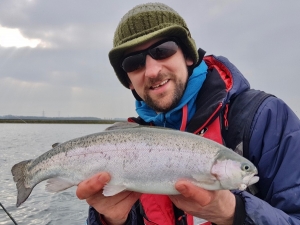
In the end, we had a stupendous couple of hours in the afternoon where sport was transformed. Various patterns worked, from classic flashy Boobies in white or pearl to the classic black and green combo, but a Snake Booby was also great fun. The latter drew even more takes, if anything, but fewer hookups. Tom finished with eight fish exluding the bonus pike, and I felt quite pleased to finish anywhere near his total with six of my own. His were bigger on average, it must be said, with a couple around the four-pound mark.

In fact, we had such a pleasant change of fortune in the afternoon I couldn’t help also wondering if the pike might also have woken up. Hence I couldn’t resist a final hour or so wandering the banks for a spot of fly fishing for pike. There are some sensational specimens in here, but it is challenging fishing and on this occasion we didn’t get that sudden take. I’ll just have to come back another day then- although I think the trout fishing is so exceptional it might be a battle of willpower just to keep the mind focussed elsewhere!
A tally of fourteen fish between two anglers on the bitterest day is certainly rewarding- but nothing too exceptional here once you find the fish and what they want. And bloody hell, do they pull!
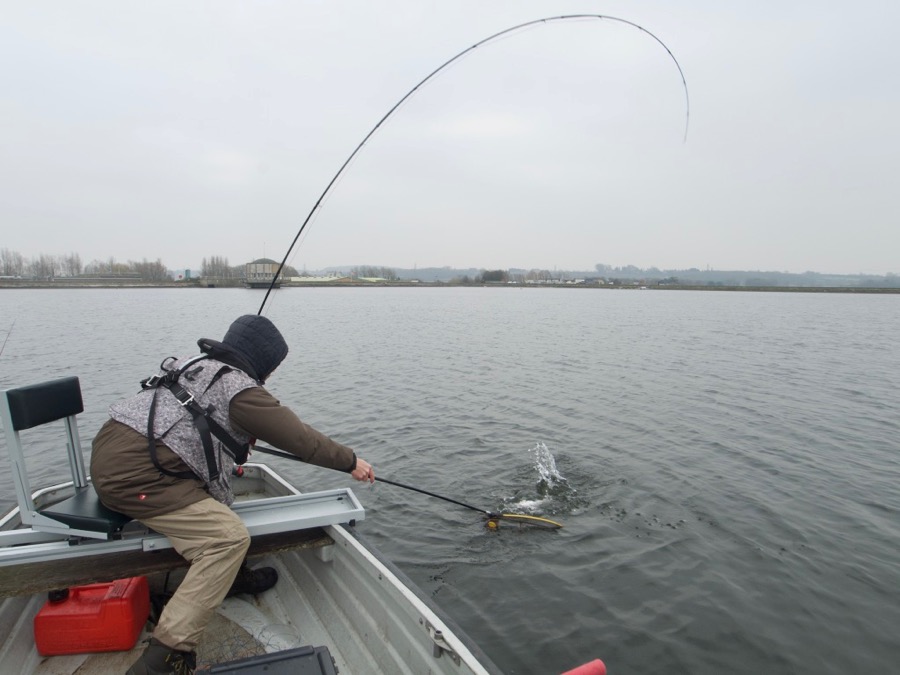
Besides thanking Tom for his excellent company, I’d also briefly like to thank the staff at Farmoor, and Will Barnard, for their helpful advice and warm welcome at the venue. It’s these bits of insight and generosity that can make all the difference to a visitor, especially on a cold day. Long story short, do have a chat with the staff if you go to Farmoor and be sure to use the tackle shop and cafe- they’re there to help and will tell you the best current advice and set you off in the right direction.
A quick plea…
Whether you’ve found this blog for the first time or are a regular reader, I’d like to finish this post with a quick request. The fishing world is in a tough place at the moment with regards to our written media. We all love to get something for free… but unless the contributors get something back, the future isn’t going to be great. So, if you enjoy reading stories and articles, whether it’s tips and advice or more reflective writing, do please keep supporting our magazines and buying both real and digital books!
Whatever your tastes, there is certainly plenty to read at the moment. Fly Fishing & Fly Tying is still going strong and for those who like variety, my article for on fly fishing for perch is in the March issue (pictured below). The next one after (April issue) will also have a special roundup on the “Fly For Coarse” competition, with some amazing catches.

Meanwhile, if you enjoy a good fishing story, you can read two dozen of my best and most entertaining angling tales in the book Crooked Lines. Accompanied by original artwork and photography, plus a foreword by Matt Hayes, it’s a steal at just a tenner and will appeal to anglers of all tastes. Click here to find out more:
https://dgfishing.co.uk/shop/crooked-lines/
Last but not least, I also hope that something positive can come after the demise of Total Flyfisher magazine. I know that Andy Taylor and his contributors are working hard to produce a new title which will be both an online and a print quarterly, entitled Today’s FlyFisher. You can read some initial articles and get a taste of what’s to come here: http://todaysflyfisher.com/


